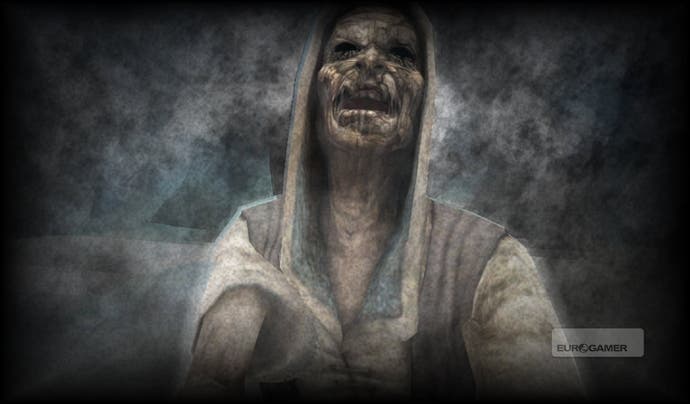Cursed Mountain
Cliff hanger.
Once a spirit is sufficiently weakened a 'prayer symbol' starts to glow within it. Lock onto this and the spirit can be compassionately cleansed with a ritual, freeing it to continue the cycle of existence and giving you a handy health bonus. Rituals are performed via a series of simple gesture controls, indicated on screen once a 'lock' has been activated.
These rituals usually consist of sweeps and pushes of the Wii remote and nunchuck, movements apparently influenced by real life Buddhist prayers. These movements are intended, we're told, as a counterpoint to the traditionally tight and tense stance usually experienced by survival horror players.
This was, in fact, the influence behind the decision to pick the Wii as a platform - initially Deep Silver wanted a game without weapons, using only these prayer gestures to exorcise without resorting to violence. A few months and some focus testing later and traditional combat has earned its place in the game, although at a diminished level in comparison to obvious genre compatriots such as Silent Hill.
It's a nice idea and fits well with the Buddhist ethos - although conversely it's the prayer gestures that feel like an afterthought addition rather than the traditional shoot-and-slash. Movement is a little awkward, and the camera also suffers a little when pushed in to tight confines, but cumbersome turns and claustrophobic combat conditions tend to emphasise the cloying nature of the ethereal foes.

We also witnessed a boss-fight against a ghastly avian - nothing spectacular in concept, but nicely executed with the usual gentle puzzle-solving element duly attached.
Exploration continues the theme, with a decent variety of environments featured. We saw abandoned monasteries, villages, ice caverns and exposed mountainsides. Each was well realised and solid, the built environments contrasting colourfully with the subdued hues of the natural settings without being garish enough to damage the noirish feel.
There's a surprising amount of detail being churned out by the proprietary Athena engine, too. Colourful mandalas bedeck the walls of buildings and grainy flecks of coalesced evil dance around the screen when the C-button is clicked to take a peek into the Bardo.

Deep Silver seems very pleased with the fact the entirety of the game environment is visible from the outside locations. This might sound impressive, but really it boils down to having a grey smear on the mountainous horizon when in the city of Lhando, and much later discovering that greay smear is actually an abandoned monastery. Once up the mountain you can peer back down to a greasy representation of the city you've just left. Nice touch, but it's a bit worrying that so much is being made of it.
Overall, however, Cursed Mountain gives the impression of being a dark and adult-orientated game. There's clearly an effort to stand out from the crowd with the refreshing framework and setting. It's certainly atmospheric and well put together, and it was only because I'm terribly, terribly brave that I wasn't actually scared. At ten hours-plus there's also a fair bit of depth and exploration to be done here - a few finer points ironed out and we could be looking at a cult hit.
Koch Media plans to publish Cursed Mountain this autumn.




.png?width=291&height=164&fit=crop&quality=80&format=jpg&auto=webp)



